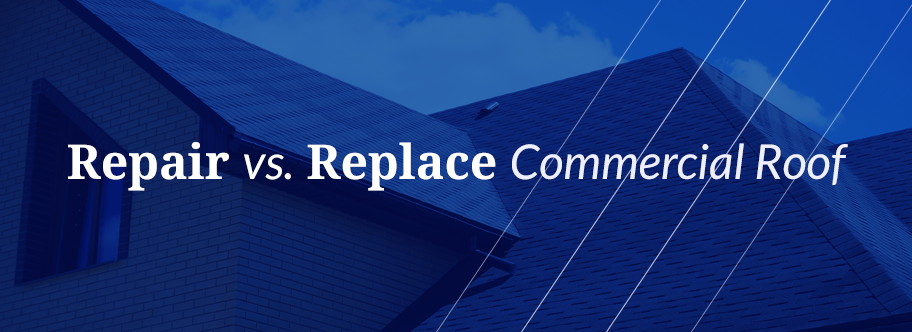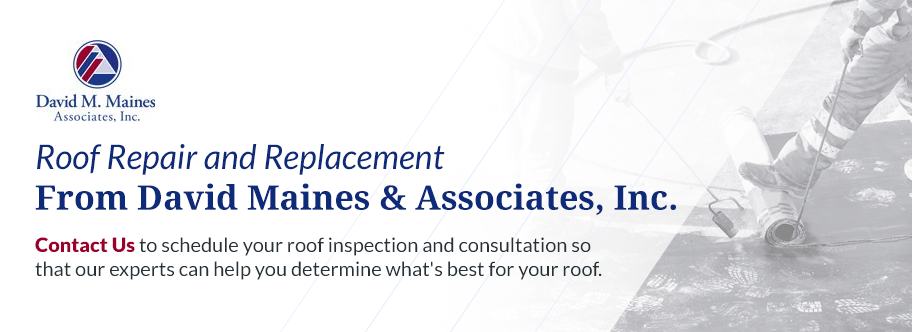Table of Contents
- Signs of Commercial Roof Damage
- Causes of Commercial Roof Damage and Leaks
- Commercial Roof Leak: Considerations
- Roof Repair vs Replace
- Roof Repair and Replacement From David Maines & Associates, Inc.
Should I replace my commercial roof? That is one of the most common questions asked by building owners in regards to a range of problems, from isolated leaks to extensive roof decay. By knowing when to repair or replace a commercial roof, you can earmark funds accordingly and have the work scheduled and ultimately completed in good time.
Signs of Commercial Roof Damage
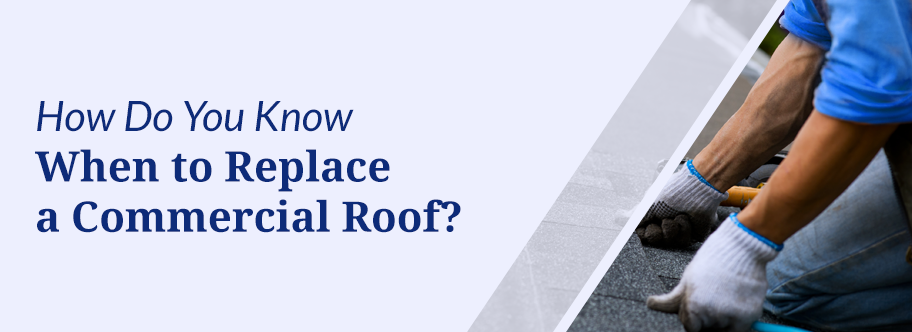
How do you know when to replace a commercial roof? The following symptoms are tell-tale signs of when a roof is in need of major repairs if not an outright replacement.
- Missing Shingles – If a shingle is missing from the roof of a building, the empty spot serves as an opening for rainwater. As soon as the water makes its way under the shingles and penetrates the leak barrier, the water can then saturate certain spots and ultimately leak in through the roof.
- Stains Coming Through the Ceiling or Walls – Roof leaks are often the result of puddle saturation. As such, the point of entry for a leak will often be surrounded by water stains. If the leak is near a wall, the upper portion of that wall is also liable to have water stains.
- Signs of Mold or Odor – When foul odors slowly permeate a room, the smell is usually the result of mold, which forms when water dries on a surface. If a roof leak goes undetected for several weeks or months, odorous mold formations could possibly be your first clue.
- Water Puddles – The most obvious sign of a roof leak is the presence of a water puddle on the floor of an interior space. Consequently, this is the most serious symptom of a roof leak since the water is directly leaking through a hole in the roof and not merely seeping through at a saturation point.
Causes of Commercial Roof Damage and Leaks
A commercial roof leak can develop for many reasons, from cracks and punctures to damaged roofing components and excess water buildup.
- No Drainage System in place – The rooftops of commercial buildings are typically flat. That said, water puddles are not intended to accumulate on the roof. A roof must have a working drainage system in place to ensure that rainwater drains to the gutters and drains. If water does happen to accumulate, your building could be in for problems regardless of the roof’s strength.For starters, water buildup can put tremendous weight on a roof. With each square foot of ponding water, approximately five pounds of weight are added to the roof per square inch. Consequently, the roof is liable to become saturated and develop soft spots in certain areas.
- Damaged Flashing – One of the most common entry points for water on a flat rooftop is along the flashing. At the junctures where roofing angles meet, flashing serves as the protective barrier that seals the cracks along the seams. Flashing consists of membrane or metal that fold along these parts of the roof.Flashing, however, can wear down after a series of hot and cold seasons. With each drastic change of weather, a building’s roofing system will expand and contract ever so slightly. Over time, this process can cause the flashing to lose its fitting. Consequently, water can make its way under the flashing and in through the roof.
- Damaged Membrane – On a commercial rooftop, the last protective barrier between the elements and the raw roofing material is the outer membrane. Just as laminate renders paper strong and waterproof, the membrane on a roof causes water to slide to the drains instead of saturating the surface. That said, a membrane can only bear so much exposure over the years before the layer gives way in select areas.As the membrane gives way, cracks or blisters are liable to form along areas of high water exposure. Once the membrane has been punctured, water can gradually make its way through to the raw roofing material and form points of saturation and leakage.
- Open Pipes or Drains on the Roof – Along the roof of any building, openings exist that allow air filtration between the outside and interior. While these openings are designed to prevent the entrance of water, puddles and rain droplets can make their way inside if the openings are not properly secured.If the pipes along a roof are not adequately sealed and secured along the base, water can seep through and gradually saturate the roofing insulation. The chances of this happening are liable to increase if the roof lacks a functioning drainage system, as pooling water could ultimately rise to the level of the entrance vents and valves.
- Roof Cracks or Punctures – The most clear-cut entryway for water along a rooftop is when cracks form along the outer surface. When a crack begins at one point, it is liable to spread and extend the initial damage. Even if the crack doesn’t cut through the roofing layer at first, the gap is likely to deepen and widen as it spreads.If the roof already has faulty drains, the puddles that form could easily find a new drainage point if a crack is nearby. Once the water makes its way through, the roofing insulation is bound to become saturated. If you see a puddle on the floor of the building’s interior, the crack has reached an advanced state.
- Weathered and Aged Roofing – The elements of the four seasons can gradually degrade a roof over a span of years. As wind, snow, hail and sunlight hit a rooftop, the membrane is heated, cooled and assaulted constantly. Even on the strongest of roofs, the forces of time are bound to take their toll.Snow can wear away at the external layer of a flat rooftop due to all the excess weight that inches of snow inflict on the structure. A snow layer is essentially a puddle that won’t immediately drain but can saturate the outer membrane. Snow is even more troublesome during extended periods of subzero temperatures when it sticks and accumulates for days and possibly weeks.
Commercial Roof Leak: Considerations
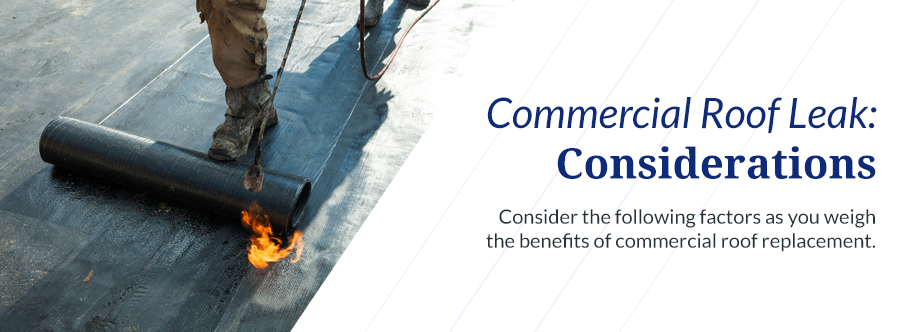
Knowing when to replace a commercial roof is important if you own a building that is currently in use. Consider the following factors as you weigh the benefits of commercial roof replacement.
- The Age of the Roof – No roof can last forever. Regardless of the initial strength, material or reinforcements of a commercial rooftop, the majority of roofing systems last for about two decades. Once 15 years have passed since the date of installation, a roof is in the late stage of its lifespan and should be monitored more frequently for signs of wear and tear.Granted, the ultimate lifespan of a roof can depend on the materials in question. If the roof is comprised of low-grade materials, it could easily need replacing after 15 years. If stronger materials were used in the roofing construction, the roof could possibly last 20 years or more with proper maintenance and upkeep. Of course, local climate and weather patterns can also affect the longevity of a roof.
- History of Leaks or Damage – The frequency of problems with a given roof should serve as an indicator of whether the roof is even worth saving. If a 10-year-old roof had one instance of leakage that was ultimately spotted and fixed with no further problems, the roof is likely going to last another 10 years. If a roof of similar age has had repeated instances of leakage, saturation and crack formation, the roof is not likely to be reliable going forward.When it comes to judging the overall quality of a roof, a standard similar to the three-strikes policy could be applied with considerable accuracy. Basically, one leak could be viewed as an isolated and fixable problem, two leaks should be viewed with more serious concern and three leaks should serve as an indicator that the roof lacks solidity, especially if the three leaks are spaced out along different areas of the roof.
- Other Roof Damage – If a roof is damaged, leaks will probably form along the affected areas. For example, a roof with shingles is vulnerable to leakage in any spot where a shingle has cracked or broken off entirely. If numerous shingles have broken off across the roof, the roofing itself should either be covered or replaced altogether.In some cases, you might find leakage isolated in one area, yet also find other forms of damage along the roof as a whole. If a crack forms in one spot but other areas are plagued with saturation, corrosion or damaged flashing, chances are the roof will develop other leaky spots in the near future. In all likelihood, the repair of one leak would merely serve as a short-term fix to a long-term problem.
- Rising Energy Bills – One of the less obvious though indeed burdensome effects of a failing roof is the rising energy bill. The problem here is that the shift is usually so subtle that it might take several years to identify roofing as the culprit behind those slowly rising monthly charges. After all, rising energy costs could be attributed to several factors — rising rates, wasteful energy consumption — that would need to be ruled out first.If you have determined that building-wide habits regarding energy usage have remained the same, yet the HVAC system has become less efficient despite being relatively new and periodically serviced, worn roofing could be the source of the problem. As such, a new roof could bring welcome relief in the form of lower energy costs.
- The Current Status of the Building – Solid, leak-free roofing is crucial for all commercial buildings in active use. When a building falls into disuse, the story changes. In fact, there are many abandoned buildings that cannot be occupied in their current state because the roofs have long been in disrepair.When it comes to roof work of any kind, prioritize and evaluate all your options before you made a decision. If you have several buildings and are crunching numbers on roof repair costs, consider the current status of each building. If a given building is currently unoccupied and is not the subject of any upcoming plans, it might not top your priority list. On the other hand, if it’s perpetually vacant because of a bad roof, you might want to take care of it right away to entice potential tenants with a new roof.
Roof Repair vs Replace
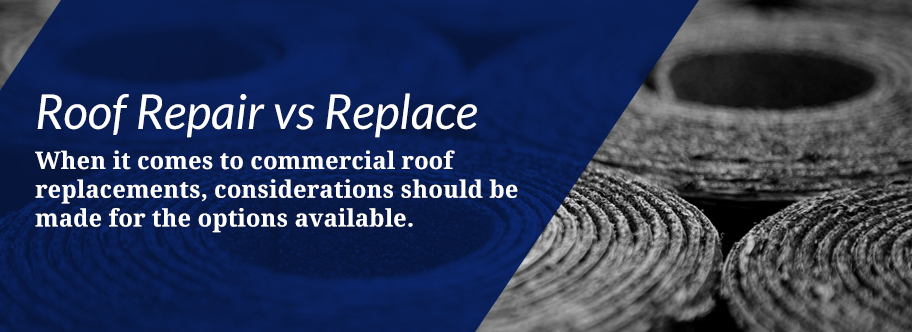
When it comes to commercial roof replacements, considerations should be made for the options available.
Benefits of Roof Repair
When the problem with a roof is small and isolated to one area, the best solution is to salvage the roof and fix the problem with easy, low-cost repairs to your commercial roof. Examples of roofing issues that could easily be rectified with simple repairs may include the following:
- Damage is isolated in one spot and the rest of the roof has a healthy membrane, fitted flashing and optimal insulation.
- The roof was partially damaged due to a hurricane or blizzard, but has otherwise been free of problems and should have many years of use left.
If you wish to keep roofing costs low, repair work is more practical than commercial roofing replacements. The best thing about the repair option is that it extends the life of existing roofing.
Benefits of Roof Coating
A roof can be coated or re-covered in order to extend its life. When you give your roof a new membrane, the benefits are as follows:
- Super resistance from leaks.
- Reflection, rather than absorption, of UV rays. Therefore, cooler indoor temperatures, less A/C usage and lower energy consumption.
- Improved exterior aesthetic and indoor comfort.
- Less disruptive to the exterior structure.
Overall, recoating is a far more economical option than an all-out roof replacement, which requires more time and resources. With a newly applied membrane, you can make the most of an existing roof.
Benefits of Roof Replacement
There come times when a commercial roof replacement is the only remaining practical option. If the damage on your roof is so large that repairs would amount to an incomplete replacement, you might as well replace your commercial roof instead. Alternately, if the roof was coated once, it cannot be coated a second time. The benefits of replacing your commercial roof are as follows:
- An entirely new roof free of any cracks or holes. On an older roof, you could have one hole repaired, only to discover another hole the following month.
- Brand new insulation, free of wear or water saturation.
- The investment will last the better part of two decades, if not longer. Moreover, the roof will consist of today’s stronger components and engineering.
If you plan to conduct business and rent out space for years to come in the building, a new roof will keep the property well-equipped for the long haul. New roofing also reduces the need for maintenance and provides superior insulation, thus yielding more savings in terms of service costs and energy usage.
Roof Repair and Replacement From David Maines & Associates, Inc.
Commercial buildings require secure and optimal roofing quality. To ensure the quality of a roofing system, the roof must be inspected on a periodic basis. For buildings in the Mid-Atlantic, David Maines has been the leading commercial roofing service provider for 28 years. Contact us to schedule your roof inspection and consultation so that our experts can help you determine what’s best for your roof.
Contact David Maines for Roofing Service
Give Us A Call or fill out our contact form!
